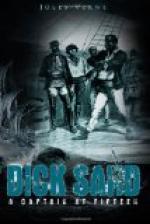Various drinks, which the little natives cried about in a squeaking voice, enticed the unwary, in the form of plantain wine, “pombe,” a liquor in great demand, “malofou,” sweet beer, made from the fruit of the banana-tree and mead, a limpid mixture of honey and water fermented with malt.
But what made the Kazounde market still more curious was the commerce in stuffs and ivory.
In the line of stuffs, one might count by thousands of “choukkas” or armfuls, the “Mericani” unbleached calico, come from Salem, in Massachusetts, the “kanaki,” a blue gingham, thirty-four inches wide, the “sohari,” a stuff in blue and white squares, with a red border, mixed with small blue stripes. It is cheaper than the “dioulis,” a silk from Surat, with a green, red or yellow ground, which is worth from seventy to eighty dollars for a remnant of three yards when woven with gold.
As for ivory, it was brought from all parts of Central Africa, being destined for Khartoum, Zanzibar, or Natal. A large number of merchants are employed solely in this branch of African commerce.
Imagine how many elephants are killed to furnish the five hundred thousand kilograms of ivory, which are annually exported to European markets, and principally to the English! The western coast of Africa alone produces one hundred and forty tons of this precious substance. The average weight is twenty-eight pounds for a pair of elephant’s tusks, which, in 1874, were valued as high as fifteen hundred francs; but there are some that weigh one hundred and seventy-five pounds, and at the Kazounde market, admirers would have found some admirable ones. They were of an opaque ivory, translucid, soft under the tool, and with a brown rind, preserving its whiteness and not growing yellow with time like the ivories of other provinces.
And, now, how are these various business affairs regulated between buyers and sellers? What is the current coin? As we have said, for the African traders this money is the slave.
The native pays in glass beads of Venetian manufacture, called “catchocolos,” when they are of a lime white; “bouboulous,” when they are black; “sikounderetches,” when they are red. These beads or pearls, strung in ten rows or “khetes,” going twice around the neck, make the “foundo,” which is of great value. The usual measure of the beads is the “frasilah,” which weighs seventy pounds. Livingstone, Cameron, and Stanley were always careful to be abundantly provided with this money.
In default of glass beads, the “pice,” a Zanzibar piece, worth four centimes, and the “vroungouas,” shells peculiar to the eastern coasts, are current in the markets of the African continent. As for the cannibal tribes, they attach a certain value to the teeth of the human jaw, and at the “lakoni,” these chaplets were to be seen on the necks of natives, who had no doubt eaten their producers; but these teeth were ceasing to be used as money.




